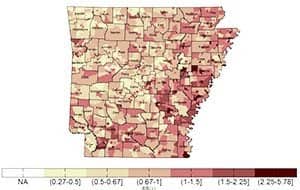UAMS, Arkansas Health Department Study Ties Neighborhood, Income, Education to Stroke Risk
The neighborhood where you live is a risk factor for stroke, says a multi-year study led by Appathurai Balamurugan, M.D., M.P.H., of the University of Arkansas for Medical Sciences (UAMS), and Arkansas Department of Health.
The study, published in the October issue of the journal Circulation: Cardiovascular Quality and Outcomes, was conducted by researchers at the UAMS Fay W. Boozman College of Public Health, UAMS College of Medicine and the Arkansas Department of Health.
It assessed the neighborhood factors associated with the risk of dying due to stroke by looking at the smallest geographical unit possible — census block groups.
“The study identifies neighborhoods in Arkansas with high rates of death due to stroke and assesses the localized distribution of risk factors,” said Bob Delongchamp, Ph.D., a professor in the Department of Epidemiology in UAMS College of Public Health, and a co-investigator.
The study was the first of its kind to estimate the risk of dying from stroke at the block group level. The study analyzed 8,930 stroke deaths in Arkansas during 2005-2009 at the block group level and found there is a wide variation in risk of death due to stroke, sometimes even a four-fold difference between adjacent neighborhoods.
Investigators have long associated hypertension and high cholesterol, as well as being African-American, with a higher risk of death from stroke. The study showed that neighborhood poverty and low educational attainment play a bigger role than race and ethnicity.
“The findings are significant. Neighborhood poverty and low educational attainment is as important as blood pressure control when it comes to deaths due to stroke,” Balamurugan said.
Data for the study came from the Vital Statistics branch of the Arkansas Department of Health and the American Community Survey. Balamurugan, an assistant professor of family and preventive medicine in the UAMS College of Medicine and assistant professor of epidemiology in the College of Public Health, is also medical director for the Chronic Disease Prevention and Control Branch at the Department of Health.
Joseph Bates, M.D., deputy state health officer for the Arkansas Department of Health, associate dean for UAMS College of Public Health and a co-investigator, said, “Arkansas is ranked No. 1 in stroke deaths in the United States, and lowering the Arkansas death rate from stroke is a high health priority for the state.”
Jawahar Mehta, M.D., Ph.D., who holds the Stebbins Chair in the Division of Cardiology in UAMS College of Medicine and is a co-investigator, said he hopes these findings will increase awareness among physicians of the need to address the risk factors for stroke in Arkansas. |

